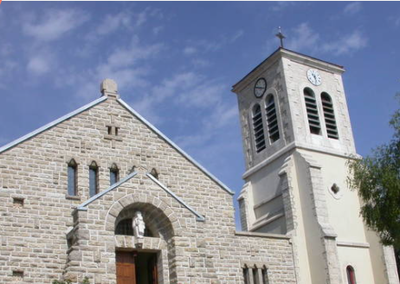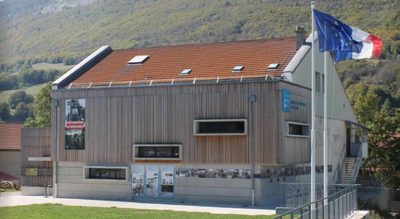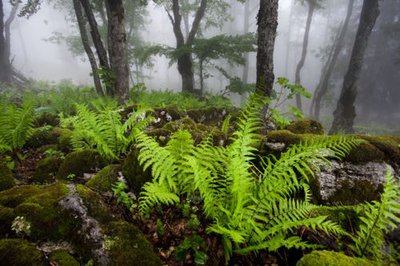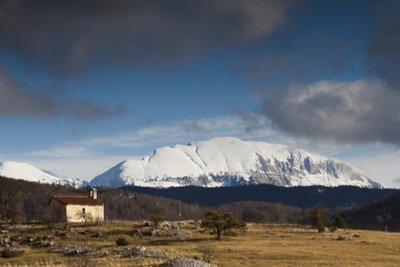The Gagères via the Chau pass

Vassieux-en-Vercors



The Gagères via the Chau pass
4h30
11,8km
+612m
-611m
Embed this item to access it offline
Immerse yourself in a part of the history of the Vercors by going to discover the village of Vassieux-en-Vercors. The Memorial and the Necropolis of the Resistance, as well as its Museum of Prehistory, bear witness to a rich but also a dramatic past.
On the plateau of Font d'Urle, you will be able to contemplate its great natural spaces with magnificent views of the massif of Vercors and the Pre-Alps of the South.
On the plateau of Font d'Urle, you will be able to contemplate its great natural spaces with magnificent views of the massif of Vercors and the Pre-Alps of the South.
7 points of interest

Martyrologe - Focus outdoor Vassieux-en-Vercors
Vassieux-en-Vercors is a place of resistance, and remains forever marked by history. Vassieux is one of the 5 towns and villages of France named after the Companions of the Liberation by General de Gaulle. The village paid a heavy tribute to the help brought by its inhabitants to the maquis of the Vercors. In fact, while the maquis were waiting for a parachute of provisions and weapons, it was the Nazis who sprang up in gliders and landed in the plain of Vassieux, on July 21, 1944. The massacre that followed sounded the end Of resistance in the Vercors. In the central square, a commemorative plaque (a martyrologist) honors the names of the inhabitants, 76 women, children and men who lost their lives on the 430 inhabitants of the village. The Memorial of the Resistance invites us to reflection and to remember. But Vassieux also retains the traces of an earlier history: that of prehistoric men, using an important deposit of flint, evoked by the Museum of Prehistory.
Eglise Vassieux - E. Georges Vassieux church
The church of Vassieux-en-Vercors was not spared during the bombing raids of World War II, and the bell tower is all that remains of the old building. The new church adjoining the bell tower (the only preserved edifice) was designed by the architect Pierre Myassard. The choir was reoriented to the west during the rebuilding work, and the decorative style was executed by the painters Aujame, Humblot and Borgès, the Grenoble glassmaker Montfallet and the sculptor Emile Gilioli. The painting of the choir was replaced by an altarpiece by the artist Carmelo Zagari; two stained-glass windows and the altar were designed by Jean-Marc-Cérino. The altar, which is made from Tavel stone, houses the relics of Edith Stein, a German Jew who became a Carmelite and died while being deported to Auschwitz in 1942.
MRV - Département de la Drôme Departmental Museum of the Resistance
The museum, which was founded by an old member of the Resistance, was renovated in its entirety in 2010. The museum tour is dotted with rich collections, connecting the revived history of the maquis and the rebuilding with the first-hand accounts of its founder. The tour is interspersed with a lavish collection of objects from the period and tactile terminals, and is structured around three themes: The Vercors before the Vercors, which presents the local and international context from 1918 to 1942; The Vercors Maquis, which contextualises the history of the Maquis from late 1942 to August 1944; and The Vercors after the Vercors, which details the post-war period, the reconstruction of the Vercors, commemorations and memorial buildings.
M. Rocheblave Memorial architecture walk
From the car park at Col de la Chau, various information points explain the aims and ideas of the architects who designed the building that houses the Mémorial de la Résistance.
Information point 1: The geography of Vassieux; why choose to build the Memorial here?
Information point 2: The look-outs: chimney stacks on the roof of the Memorial
Information point 3: The different phases of the project
Information point 4: The potency of the architecture
Information point 5: The link with Camp 6
Lente - S&M Booth Forest of Lente
With its 3000 hectares located between 1100 m and 1600 m of altitude, the forest of Lente is mainly composed of beeches exploited formerly for the coal, as well as softwoods exploited for the construction of mats for the navy. The forest home includes 5 types of ungulates: chamois, roe deer, deer, mouflons and wild boars.
Font d'Urle - S&M Booth Plateau of Font d'Urle
Property for a small part of the commune of Vassieux en Vercors, for the most part the department of Drôme since 1954, the departmental domain of Font d'Urle is a sensitive natural space. Its vocation is the protection of nature and the reception of the public. Some rules of common sense make it possible to protect this space as well as to cohabit in good understanding with the shepherds and their flocks. Picking flowers that are particularly spectacular in May and June is prohibited. Dogs, even on a leash, are prohibited during the summer season (May to October). In the middle of the mountain pastures, there are herds of horses in semi-freedom. In this vast steppe of altitude, stretch of grass and rocks "with for all border the sky" (Joseph Kessel), one would think oneself in Mongolia.
Plateau de Vassieux - S.M Booth Plateau of Vassieux
The plateau of Vassieux-en-Vercors is an open landscape characteristic of the karstic plateaus, the surface water is almost non-existent and the soils are not thick. However, dolines, which are depressions where the clay accumulates, thus allowing the cultivation of cereals, alongside these dolines, the stones are heaped up.The ruins of two old windmills are visible in the hamlet of La Mure.
Description
Departure from Vassieux-en-Vercors village, take the direction of Col de la Chau 2. At Les Chenaux 1, climb gradually up to the pass, passing the Memorial de la Résistance. From Col de la Chau, join Prairie de la Chau 3, where you will find the Grande Traversée du Vercors and then the Pot de la Croix 4. To take the GR 93 (white and red markings) to Col de Font Payanne 6, via Les Gagères 5, this part of the itinerary offers several remarkable views on Vassieux and the eastern border of the Vercors . From there, take the direction of Vassieux and descend gradually to reach the crossroads Cerisiers 7, the village is then far away.
- Departure : Vassieux-en-Vercors (parking village)
- Arrival : Vassieux-en-Vercors (parking village)
- Towns crossed : Vassieux-en-Vercors, Bouvante, and Saint-Julien-en-Quint
Forecast
Altimetric profile
Recommandations
Be careful, you are momentarily on summery areas, maybe you will meet dogs protecting herds, often Patou.
Always be sure to bypass the herds, while remaining calm while the protective dog identifies you, not caressing them or threatening them!
Presence of dogs forbidden on all the plateau of Font d'Urle (Natural Sensitive Area) from 01 June to 30 October.
Always be sure to bypass the herds, while remaining calm while the protective dog identifies you, not caressing them or threatening them!
Presence of dogs forbidden on all the plateau of Font d'Urle (Natural Sensitive Area) from 01 June to 30 October.
Herd protection dogs
In the mountain pastures, the guard dogs are there to protect the herds from predators.
When I hike, I adapt my behaviour by going around the herd and pausing so that the dog can identify me.
Click here to see the video : c'est quoi au juste un chien de protection ?
Information desks
Place Pietri, 26 420 La Chapelle-en-Vercors
Transport
By train :
Valence train stations
OùRA multimodal route planner : https://www.oura.com/
By bus :
From Valence : Line D05 to Vassieux-en-Vercors
By hitch hiking : You can get there / get back by hitching a lift with the Rezo Pouce network from Autrans-Méaudre, Lans-en-Vercors, Grenoble and Royans-Vercors (you can find all the stops in the Vercors on www.rezopouce.fr).
Carpooling :
Offer your services or book your carpooling on the regional Mov'Ici platform.
Valence train stations
OùRA multimodal route planner : https://www.oura.com/
By bus :
From Valence : Line D05 to Vassieux-en-Vercors
By hitch hiking : You can get there / get back by hitching a lift with the Rezo Pouce network from Autrans-Méaudre, Lans-en-Vercors, Grenoble and Royans-Vercors (you can find all the stops in the Vercors on www.rezopouce.fr).
Carpooling :
Offer your services or book your carpooling on the regional Mov'Ici platform.
Access and parking
From the Col de Rousset, follow the D518 then the D76 towards Vassieux-en-Vercors.
From Chapelle-en-Vercors, follow the D178 towards Vassieux-en-Vercors.
From Chapelle-en-Vercors, follow the D178 towards Vassieux-en-Vercors.
Parking :
Main car park at the entrance of the village
Report a problem or an error
If you have found an error on this page or if you have noticed any problems during your hike, please report them to us here:
